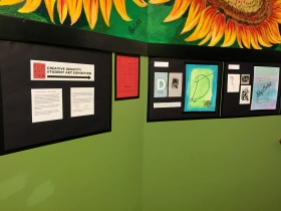






ARTS-IN-THE-SCHOOLS • THE CREATIVE IDENTITY PROJECT
“The signature is a singular fingerprint, original & distinctive to each person. And it is fast becoming extinct,” says Laura Leiman, graphic artist and recent Regional Arts & Culture Council grant recipient.
During the past five years while mentoring middle school students, artist, Laura Leiman, noticed most students printed their signatures with few distinguishing qualities. In fact, it was hard to tell each students’ writing apart because everyone printed in a similar manner.
It appeared students were missing something key to individuality: the ability to communicate the written signature clearly yet uniquely as their own.
Students she had worked with in the Portland Public Schools wanted to learn cursive and calligraphy, though both are not consistently taught. More importantly students wanted to create identities uniquely their own; something they could use and develop through life.
Student curiosity and enthusiasm sparked Leiman to develop, Creative Identity, a project-based exploration of student awareness, funded by a Portland Regional Arts Council award grant. The project explored how students wanted to be viewed artistically. The project provided students the chance to draw & doodle and find the ‘me’ in letterforms & in symbols that felt right to them. Students created signatures, monograms, soap carvings and identity marks as they tried new materials such as watercolor crayons and inking pens.
Creative Identity also provided students the opportunity to put away computers & smart phones & experience the mind/body connection via one of the most fundamental & evolving art forms humans practice. Studies indicate doodling is great for concentration and brain development and can improve higher thinking, which is key to art and design.
The act of writing and doodling fosters creative thinking because it requires consideration and time, according to Ronald Kellogg, psychology professor at Saint Louis University. It engages us in a way that texting or typing can’t.
Recent studies indicate doodling can turn on neurological networks in the brain responsible for imagination & discovery. That is extremely important, Leiman thinks, for innovative & creative thinking. “The next generation of artists will still need to experience eye to hand drawing. I’ve noticed when students settle in to drawing or doodling they become more focused and calm. I believe most students think more clearly after drawing for several minutes,” says Leiman.
After participating in the 12-week project, 63 students from two Portland schools, Astor & Cesar Chavez K-8, exhibited their art work. “The result was profound,” says Leiman.
“I saw students transform their relationship to art as they experienced letterforms as artistic expression.” The project has caught the attention of other teachers and Leiman hopes to expand the project next year.
